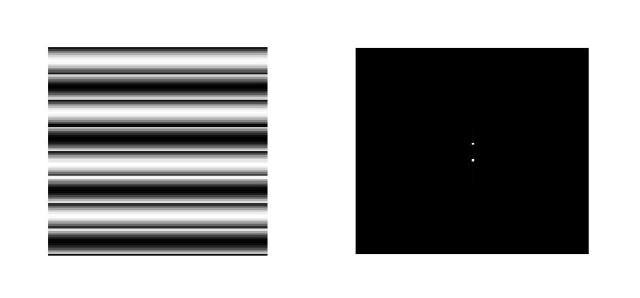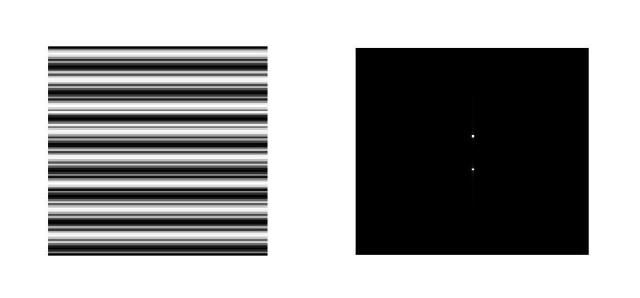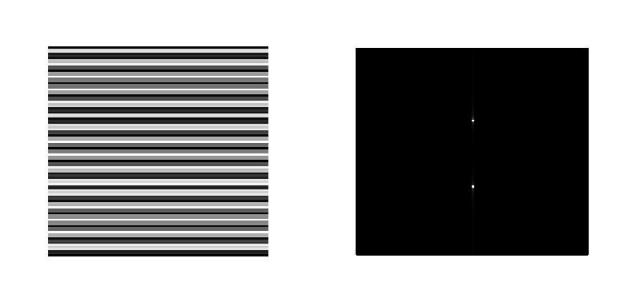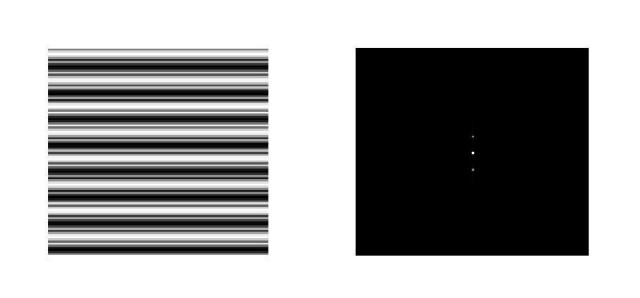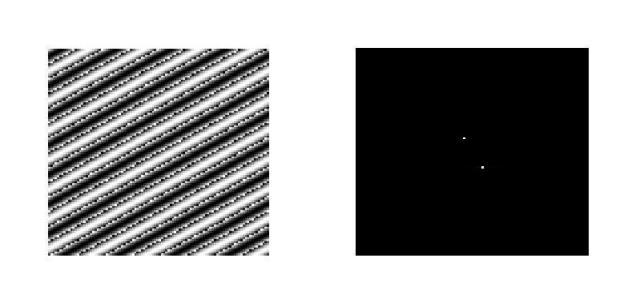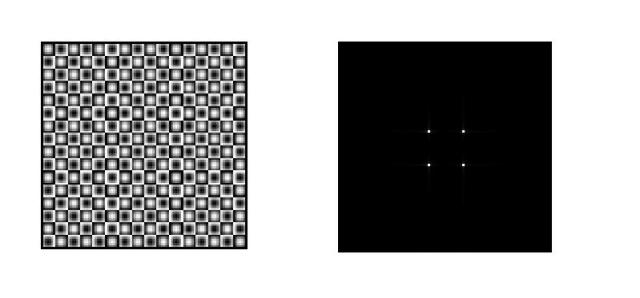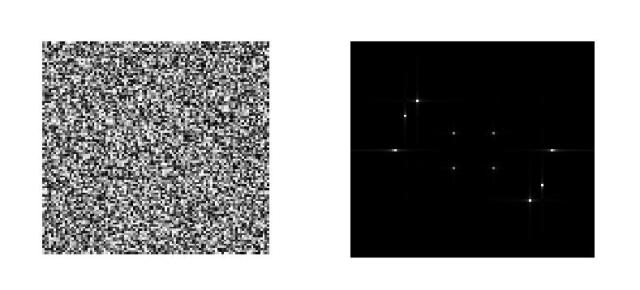The following patterns below were created in scilab and their corresponding fft’s are shown beside them.


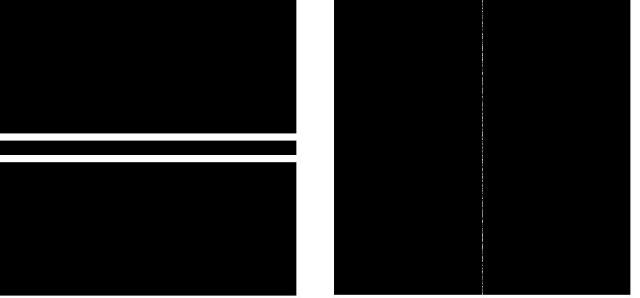
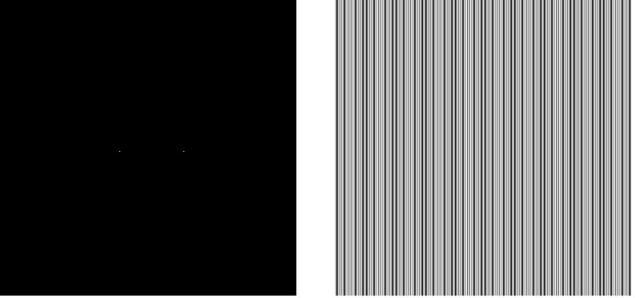
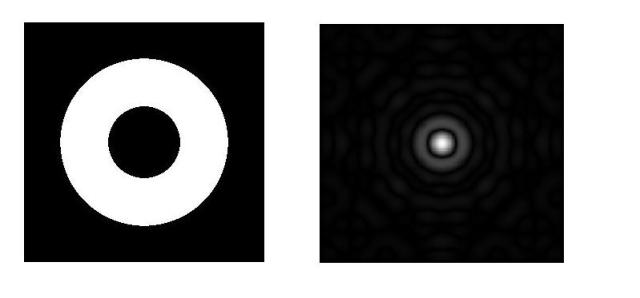 We can observe the the annular circle and square produce a pattern which form only the shape is different i.e. they resemble the original shape of the image. Since, fft is linear this suggest that their fft’s are just the different of the smaller square and circle with the larger square and circle. The pattern for the fft of a circle is an airy disc shown in activity 6. For 2 horizontal slits, we can see that the pattern formed is a vertical line with a sinusoidal behavior along the line. This is due to the fact that if we look at the horizontal side of the pattern, we can see a single value of 1 running through from end to end and the fft of that is a dirac delta which is seen as a single point if we look at the horizontal side of the image of fft. The sinusoidal behavior is due to two symmetric points about the center is seen on the vertical side of the image. For the two points, the behavior is sinusoidal along the side where two points are observed(the horizontal side) and a single value of 1 for the side where a dirac delta is observed (the vertical side).
We can observe the the annular circle and square produce a pattern which form only the shape is different i.e. they resemble the original shape of the image. Since, fft is linear this suggest that their fft’s are just the different of the smaller square and circle with the larger square and circle. The pattern for the fft of a circle is an airy disc shown in activity 6. For 2 horizontal slits, we can see that the pattern formed is a vertical line with a sinusoidal behavior along the line. This is due to the fact that if we look at the horizontal side of the pattern, we can see a single value of 1 running through from end to end and the fft of that is a dirac delta which is seen as a single point if we look at the horizontal side of the image of fft. The sinusoidal behavior is due to two symmetric points about the center is seen on the vertical side of the image. For the two points, the behavior is sinusoidal along the side where two points are observed(the horizontal side) and a single value of 1 for the side where a dirac delta is observed (the vertical side).
The next figures shows the corrugated roof image of a 3D sinusoid along the y-axis and the corresponding fft’s are beside them.
We, can see here the same thing that we see if we take the fft of two dots. Now, we can also note the inverse relation of space and frequency, that if the spacing of the sinusoidal peaks gets narrower, then the spacing of two dots gets widers. So, increasing the frequency of the sinusoid also increases the space between two dots.
Now, if we are to add to a sinusoid a constant term whose value is 1 such that there will be no negative values for the soinusoid, we can observe the image and its fft below.
We can see the same two points and the additional point in the center is due to the constant added to the function, such that as we can recall, the fft of a constant is a dirac delta.
If we rotate, the sinusoid by 30 degrees, we can observe the following.
The two points also rotated by the same amounts. Since if we look at image 30 degrees counterclockwise from the positive x-axis, we see the sinusoid ‘proper’ and so the two dots would follow the orientation of the sinusoid.
And if we try to get the product of sinusoid along the x and y-axes, we get the a figure and the fft below.
In 3D,
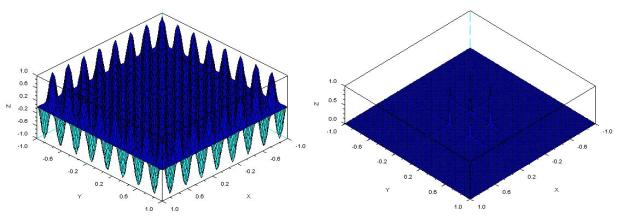 As we would expect, the fft would be four dots symmetric with respect to the center. This is due to the fact that the both sinusiods are seen when viewed along the horizontal and vertical axes so that two symmetric dots are seen when we view the fft along the same axes.
As we would expect, the fft would be four dots symmetric with respect to the center. This is due to the fact that the both sinusiods are seen when viewed along the horizontal and vertical axes so that two symmetric dots are seen when we view the fft along the same axes.
Now, if we add different rotated sinusoid from the positive y-axis by 45,60 and 90 degrees with the sinusoid above, we would just expect additional pairs of points along the same degrees as we rotated the sinusoids since the fft is linear.
The entire activity is fun, and it is basically a review of the past physics subjects. The exciting part is to know that what you already know for quite a long time is correct. The procedures were executed with less problems on programming. I give myself a perfect 10 for this.

